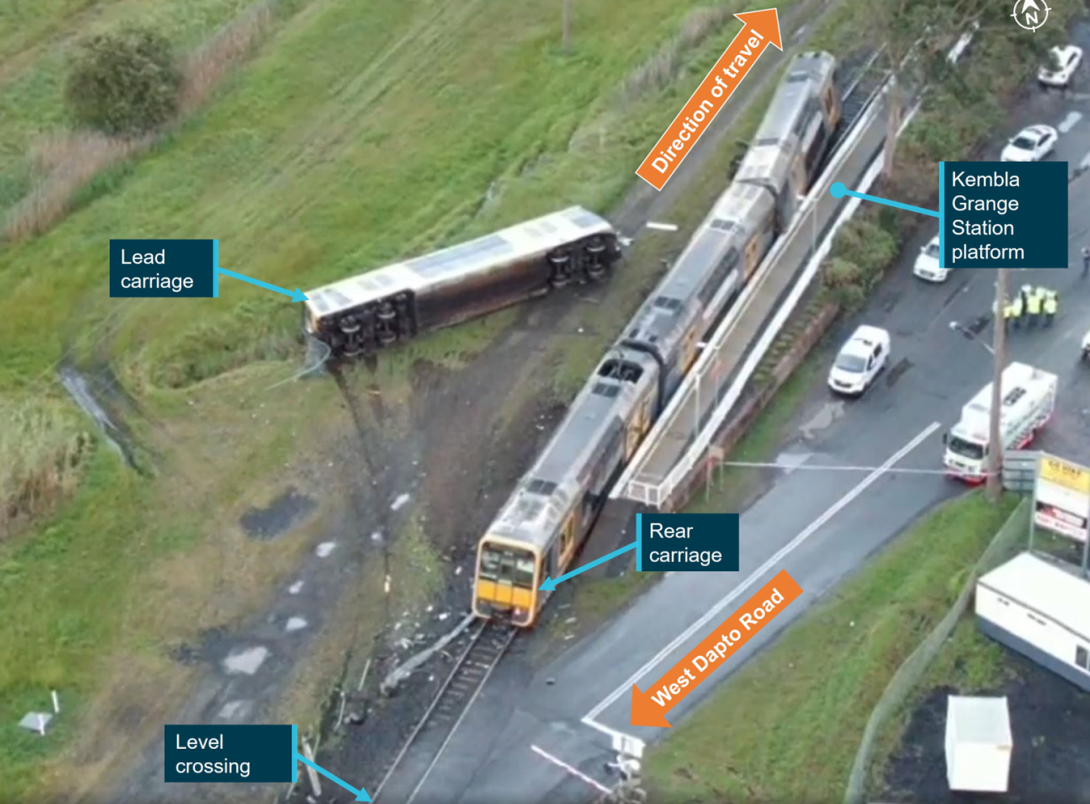
A range of safety actions have been taken in response to the derailment of a Sydney Trains passenger service which collided with an abandoned vehicle at Kembla Grange, south of Wollongong.
In the early hours of 20 October 2021, a four-carriage Tangara train was operating from Kiama towards Sydney’s Central Station when it collided with an abandoned motor vehicle on the tracks near the level crossing at West Dapto Road.
On impact, the first carriage derailed, but continued upright for about 125 m, before colliding with a stanchion, tipping on its side, jack-knifing, and separating from the rest of the train.
The train driver sustained serious injuries, and two passengers in the front carriage were also injured. There was significant damage to rolling stock, rail infrastructure and overhead wiring.
A transport safety investigation was undertaken by the Office of Transport Safety Investigations (OTSI), which conducts rail investigations in New South Wales on behalf of the ATSB.
Separately, an individual was charged by NSW Police with endangering passengers on a railway, and obstructing a railway.
“About 45 minutes before the collision, an individual moved CCTV cameras monitoring the West Dapto Road level crossing, and this tampering was not detected by Sydney Trains Security Control Centre,” OTSI Chief Investigator Jim Modrouvanos outlined.
“At some point over the next 40 minutes, a motor vehicle was driven onto the tracks, where it became stuck, and was subsequently abandoned.”
While incidents resulting from alleged criminal activity are not typically subject to transport safety investigations, this occurrence shed light on a number of broader safety factors.
Among them, the investigation identified Sydney Trains Security did not detect the camera tampering prior to the accident, with the CCTV tamper alarms not activated.
“Additionally, a member of public called triple zero to alert police of a vehicle on the rail line about four minutes before the accident – but this was not treated as an emergency by all parties involved,” Mr Modrouvanos said.
When Sydney Trains was alerted to the emergency, two minutes before the accident, this information was passed from the Security Control Centre Operator to the relevant Train Services Delivery Manager, then to the Wollongong Coast Panel Signaller, who then made a point to point call to the train driver, which was not answered.
“This process of reporting was not consistent with Sydney Trains’ Network Incident Management Plan, and not all parties in the process treated the call as an emergency,” Mr Modrouvanos explained.
After the incident, the investigation identified the train’s guard was unable to make an emergency call on the Digital Train Radio System, as it had gone into standby mode, likely due to the separation of carriages.
“The guard’s training and other available resources did not provide the knowledge needed to reboot the Digital Train Radio System,” Mr Modrouvanos said.
“Finally, the derailment brought down potentially live 1,500 V overhead wires. While the guard and first responders were moving around the wreckage to help passengers, this overhead wiring had not been confirmed as isolated.”
Since the accident, Sydney Trains conducted its own technical and systemic investigations, and shared its 14 internal recommendations with OTSI. These recommendations and additional safety issues raised by OTSI were addressed through safety actions, detailed in today’s final report.
Actions taken include updating initial training for Security Control Centre Operators to improve communication during emergencies, and a CCTV software upgrade to allow use of a centralised server-based analytics engine to provide alarm functionality.
At the time of publication, Sydney Trains remains in the process of developing, testing and trialling alarm functionality to enable detection of incidents, such as tampering, at the West Dapto level crossing, among others across its network.
Sydney Trains has also updated its Security Control Centre’s standard operating procedures, to eliminate a conflicting instruction which was also identified during the investigation.
Mr Modrouvanos welcomed the actions taken by the operator.
“All obstructions reported on the rail line should be treated as an emergency, and priority should be given to urgently stop trains on the network and avoid a collision by the most effective means available,” he said.
“More broadly, all rail operators should assess their risk exposure in circumstances where they have been unable to implement planned controls – and they should consider implementing alternative or short-term controls to reduce the risk exposure until the agreed controls are in place.”
Read the report: Collision between a passenger train and a motor vehicle, near West Dapto Road level crossing, Kembla Grange, New South Wales on 20 October 2021


